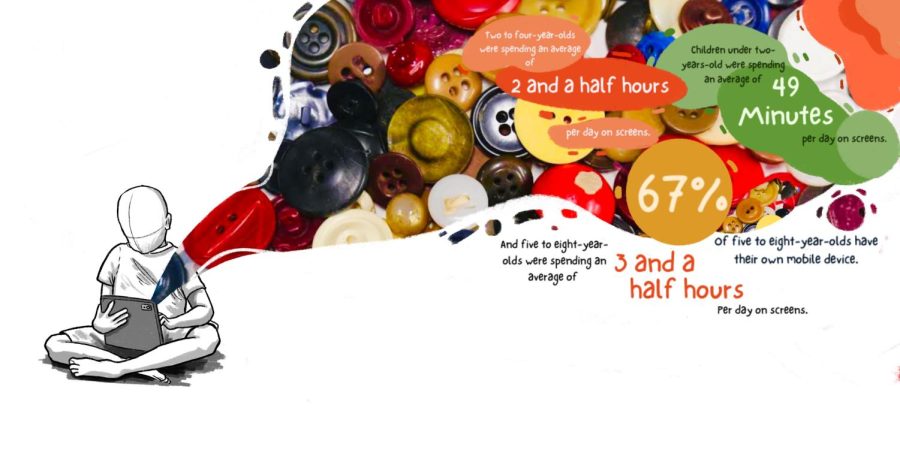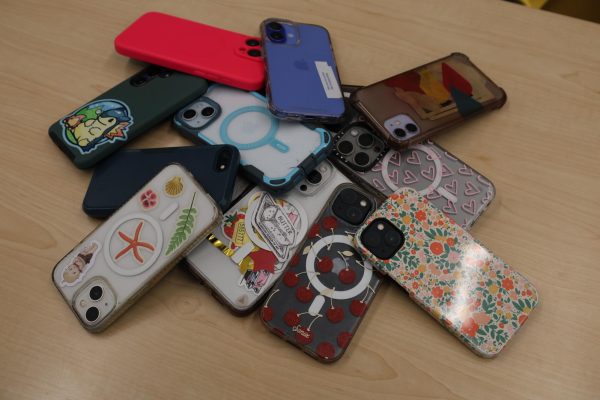A Balancing Act
Our generation has grown up with an endless digital world at their fingertips, from constant communication through texting and social media to online school. How does this affect our everyday activities and what does it mean for the future?
By middle school, phones were in all of my classmates’ hands. This marked an irreversible shift in how we interacted with each other. Instead of running around on the playground, playing board games or baking, we were huddled around devices, playing mobile games and flipping through filters. The world around us was less interesting—phones opened the door to an endless digital world.
These shiny, new objects that now occupied so many young minds sparked a wave of concern and research: What harm can these devices do?
With technology’s rapid development over recent years, children now have devices in their hands much earlier than middle school. According to a census by Common Sense Media, in 2020, 67% of five to eight year olds will have their own mobile device—up 20% since 2017. Children under two years old were spending an average of 49 minutes per day on screens, two to four-year-olds were spending an average of two and a half hours per day on screens, and five to eight-year-olds were spending an average of three hours per day on screens.
It’s beneficial for children to learn how to effectively navigate the digital world as we move further away from the analog past, but how much is too much screen exposure?
Being a teen now, it’s still hard for me to step away from a screen. It feels as though it’s pulling me in; keeping me engaged and stuck in an endless cycle of clicking and scrolling. I wonder, had I been born alongside Gen Alpha, the current youngest generation, would I have my own device by elementary school? How much of my early childhood would I spend staring, wide-eyed, at a screen?
Kristen Harrison and Sarah Domoff are two local experts on this topic. Harrison is a professor and researcher at the University of Michigan, in the Department of Communication and Media. She studies children and media and the resulting parent-child conflict over screen usage. Domoff is a licensed clinical child psychologist and associate professor in the Department of Psychology at Central Michigan University. She focuses on children and adolescent technology use in her research and clinical work. From their research, both Harrison and Domoff have found that major negative impacts of screen time for children are caused by excessive technology use cutting into the time needed for developmentally necessary activities.
According to Harrison, for many children, being in front of a screen provides sensory regulation: a place for them to be calm and engaged—to escape from reality. I can relate to this, as I too often turn to screens as a buffer from the world.
It’s not just the comfort that screens provide which keep children in front of them. A study led by German neuroscientist, Sören Krach, has shown that much of the content accessible for children to engage in falls into the category of “rewarding social stimuli,” defined as positive feelings prompted by other people. For example, seeing smiling or laughing faces and positive interactions. Rewarding social stimuli release dopamine, a chemical produced by the brain that heightens motivation and pleasure, which keeps children binging on screens for hours at a time, in turn interfering with a child’s desire to spend time doing other activities.
“If you have a choice between staying on the screen or having to get ready for bed, or staying on the screen or having to sit down for dinner, kids are going to want to have a screen—that’s natural,” said Domoff.
Domoff recommends parents look at the 24 hours in a day and subtract the slices of time needed for naps, physical activity, time with family and friends, meals and a good night’s rest. These seemingly monotonous, routine activities are important for childhood development, and frequently favoring screen time over these activities can have serious consequences on children’s mental and physical health.
“The issue is more of what [children] are not doing because they’re using screens instead,” Harrison said. “So, the goal with [children’s] screen use is not necessarily to ban all screens, but to make sure that we encourage alternate activities so they’re not missing out on important developmental milestones.”
According to Children’s Hospital Colorado, a lack of sleep can cause decreased brain development, learning difficulties and heightened negative emotions, as well as weight management problems, growth issues and increased frequency of illnesses.
“[In my field], we say you mess with sleep, you mess with everything,” Domoff said. She has found that many kids are choosing their devices over sleep and is concerned with the consequences of that. Domoff recommends that children refrain from using screen media during the hour before bedtime to combat harmful emissions of blue light, which keep children awake. Keeping all screens out of the bedroom overnight is also extremely important—it takes the choice of “device or sleep?” away from a child. “In terms of the biggest physical health impacts [screen time has on kids], it’s sleep disruption,” Domoff said.
Similar choices present themselves during the day: screens or toys and screens or physical activity. Playing with toys and staying active benefit both the mind and the body. Even simply playing with blocks, according to Northern Clinics of Istanbul, can promote the development of spatial awareness and hand-eye coordination. Spending time playing with toys helps children develop important skills on their own and allows adults and peers to engage with the child, building necessary social skills such as body language reading and teamwork.
As I look around, I can see that the digital world is undoubtedly here to stay. But how often we engage with it, outside of work and school necessity, is up to us. It’s okay to be attached to your phone—I am, too. But make the conscious decision to limit your screen time, even if “You’ve Reached Your Time Limit!” reminders are annoying.
Unfortunately, not only is removing oneself from a screen harder for young children, but the effects of excessive screen time from such an age are detrimental. Keeping screen usage to a minimum for the first several years of life is crucial and guardians should monitor their child’s time with technology through elementary school. It’s also important to have healthy discussions with children about limiting screen time and continuing to do so through middle and high school.
Moving into the future, children and parents must learn to walk the line between reality and the digital world, and find a balance between the two.










